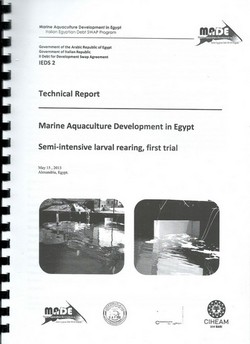
Marine Aquaculture Development in Egypt
Italian Egyptian Debt SWAP Program
Grey Mullet (Mugil cephalus) Reproduction and Larvae Rearing in K21 Marine Hacthery, Abou-Talaat, Alexandria Season 2012
January, 2013, Alexandria, Egypt.
Introduction
This report covers the executed activities in the K21 MH for the artificial propagation of the grey mullet, Mugil cephalus, in captivity and larvae rearing till reaching the fry size from 15/10/2012 to 15/1/2013. Little information on the spawning of Mugilidae in the Pacific and Indian Oceans is available except for reports on M. cephalus which spawns in late winter in the tropcs and subtropics (Nash &Shehadeh, 1980). The most abundant species of Mugilidae in Egypt waters are M. cephalus; L. ramada; L. seheli; L. saliens; L. auratus and Chelon Labrosus (Sadek, 1988). Mullet aquaculture production account for 30% of the total landed aquaculture species in 2011 (GAFRD, 2012).
Larval development of Mugilidae species has been studied by a number of people. Anderson (1957) reported on M. curema along the South Atlantic coast of the United States. Also, Anderson (1958) described and illustrated the early larval development of the grey mullet M. cephalus, and its development and growth to juvenile size in inshore areas. Demir(1971) described seven postlarvae and one juvenile of the golden mullet L. auratus, and two postlarvae of the thick-lipped mullet Chelon labrosus, ranging from 27 to 60 mm from Plymouth. Sylvester and Nash (1975) studied the relationship between temperature and the survival of the larvae of the striped mullet M. cephalus in Hawaiian waters. Larvae of M. curema from Biscayne Bay, Florida, were reared in four laboratory experiments by Houde et al. (1976). Zhutenev et al. (1976) described the young, aged 1, 2, 3, 5 and 7 days from the moment of hatching, of M. saliens ‛(=Liza saliens)’ from Black Sea. L. macrolepis was studied by James et al. (1983) from newly hatched to 132-h-old larvae. Bensam (1987) followed the development of Valamugil seheli from Palk Bay and the Gulf of Mannar in the laboratory up to the 72-h postlarva stage. A morphological and histological study of the intestine of Mugilidae (M. cephalus, L. aurata, L. ramada and L. saliens) was carried out from the larval to the adult stages by Albertini-Berhaut (1987). Cambary & Bok (1989), in South Afrika, described and illustrated the development of the larvae L. richardsonii to 46 days using drawings and photographs. Boglione et al. (1992) described the larval development stages of Chelon labrosus, a prominent species among the Mugilidae, from the Valdagri fish farm in Southern Italy (policoro, Matera). Larvae and juveniles of L. haematocheila from Takezaki, on the west of the Ariake Sound, Kyushu, were reared for about 3 months, and their early development and growth were described by Yoshimatsu et al. (1992) from a series of live specimens. Yoshimatsu et al. (1993) studied the early development, growth, and morphological changes of keel back mullet L. affinis on the basis of a series of reared specimens. From 1999 to 2003 in Italy, several M. cephalus larval rearing trials have been performed in semi intensive large volume tanks, obtaining high quality and high survival rate, after the proper methodology for the mullet larval rearing have been set up, the mullet production stopped since in Italy the market value of the mullet is not high, it was not cost effective to produce it in commercial scale. Different is the contest the importance and the value of the mullet in Egypt, making one of the most important for marine aquaculture.
The purpose of this study was to illustrate and describe the larval developmental stages of grey mullet (M. cephalus) embphasizing problems and solutions. This small field study will be of help to develop the experiment more concretely for the next season 2013 – 2014.
Contents
<!--Introduction
<!--Methodology
· <!--[endif]-->K21 MH facility versus mullet artificial propagation in captivity and larvae rearing
<!--K21 MH′s Human resources/manpower skills
<!--Water quality
<!--Broodstock husbandary
<!--Larvae rearing
<!--Results
<!--[if !supportLists]-->· Water quality season description
<!--[if !supportLists]-->· Eggs production, incubation and hatching
<!--Larval rearing
<!--Conclusion
<!--Broodstocks
<!--Larval rearing
<!--Next season plan



ساحة النقاش